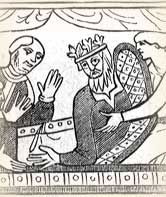
Edward the Confessor became the only English king ever to be canonized (officially named a saint) and was the builder of one of the most celebrated churches in the Christian world. Edward was next to the last of the Saxon kings. He married Edith, daughter of Godwin. On his deathbed, Edward named Edith's brother Harold to succeed him as king. But Harold could not hold the throne. Ten months after Edward's death, French from Normandy invaded England under William the Conqueror.
William's claim to the English throne was the result of an earlier invasion. When Edward was in his teens, the Danes invaded England and removed his father from the throne. Edward fled to Normandy, which was ruled by Edward's uncle. Edward actually spent a large part of his life in Normandy. He came under the influence of the Norman monks and led a devout life. He vowed to make a pilgrimage to Rome, but his half brother died and Edward suddenly was proclaimed king before he could fulfill his vow.
Edward was not particularly outstanding as a king, but he reduced taxes and lived on the income of his own lands. Despite turbulent times, he kept his nation at peace. However, he favored Normans over Saxons. This led to serious disputes with his father-in-law, Godwin. In anger at Godwin, Edward may have insulted his own wife, Edith.
It bothered Edward that he had not fulfilled his promise to make a pilgrimage to Rome. He asked the pope to release him from his vow, since the troubled condition of his land did not permit him to travel freely. The pope agreed to free Edward but only if he would rebuild the monastery of St. Peter at Westminster. The result--the Collegiate Church of St. Peter--is known today as Westminster Abbey.
The choir and part of the main worship area were dedicated on December 28, 1065. Edward was too sick to attend. The sixty-three-year-old king died just eight days later, on this date, January 5, l066. Claiming that Edward had passed the throne to him while sheltering in Normandy years earlier, William invaded England. On December 25, he was crowned King of England in Westminster Abbey. This famous church, rebuilt by later kings, has ever since continued to be the coronation church of the British monarchy.
Some time after Edward's death, Osbert of Clare and other monks of Westminster made claims that Edward had been a holy man. He was reported to have performed several miracles when touching people to heal them. King Henry II saw political advantages in strengthening the memory of Edward. He petitioned for Edward's canonization. Pope Alexander III obliged in 1161. And so Edward became an official saint of the Roman Church ninety-five years after his death.
Bibliography:
- Adapted from an earlier Christian History Institute story.
- "Edward, Saint, the Confessor." Britannica. Britannica, 1967.
- "Edward the Confessor," and "Westminster Abbey." The Oxford Dictionary of the Christian Church, edited by F. L. Cross and E. A. Livingstone. Oxford, 1997.
- Various internet articles.